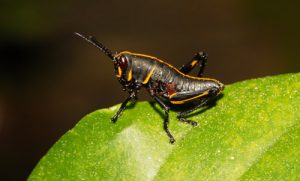Nothing causes as much panic among homeowners and gardeners as lubber grasshoppers!
You know, the tiny grasshoppers that emerge in spring, gather in groups of hundreds and grow into monsters by the end of summer. Much of this terror and fear are unwarranted, because these grasshoppers, which can be destructive in certain circumstances, aren’t as huge of a menace as you might think.
The eastern lubber grasshopper (Romalea microptera) is native to the Southeast U.S., from North Carolina to Texas. “Lubber” is derived from an old English word “lobre” which means lazy or clumsy, which is appropriate for these grasshoppers because the adults do not fly well. There is only one generation per year, with the eggs hatching in mid-March and the adults maturing in late summer/ early fall.

Lubber grasshoppers consume less food than other smaller grasshoppers do, but they have a large host range (at least 100 species of plants from 38 plant families). They are obsessed with amaryllis and other bulbs, which they will totally defoliate, and they can severely damage young citrus trees. The younger insects can be more damaging, because they are gregarious when young and large groups of them can quickly cause great damage. Fortunately, most plants in the landscape are not bothered by this grasshopper. Turfgrass and hedges are rarely damaged even if you see the grasshoppers just “hanging out”.
The most effective way of controlling this pest is to diligently round them up and dispose of them early in the spring, just after they have hatched. Gardeners who do this for several years report that they can dramatically reduce their numbers because they only have one generation per year. If allowed to mature to adults there are no insecticides that are effective, so start searching early for your dreaded lubbers and stop them before they become monsters.
For more information read the University of Florida factsheet at:
http://edis.ifas.ufl.edu/in132
Or the Featured Creatures article at:
http://entnemdept.ifas.ufl.edu/creatures/orn/lubber.htm
Videos of our educational classes are available on YouTube at: https://www.youtube.com/channel/UCc-5xumLShn-54EUdsHRXRA/videos
Listen to podcasts of our weekly Virtual Plant Clinic at: https://anchor.fm/william-j-lester
Visit our Facebook page for more great information at: https://www.facebook.com/HernandoExt
And for a full listing of all our upcoming educational classes go to: https://hernandoextension.com/
 0
0
